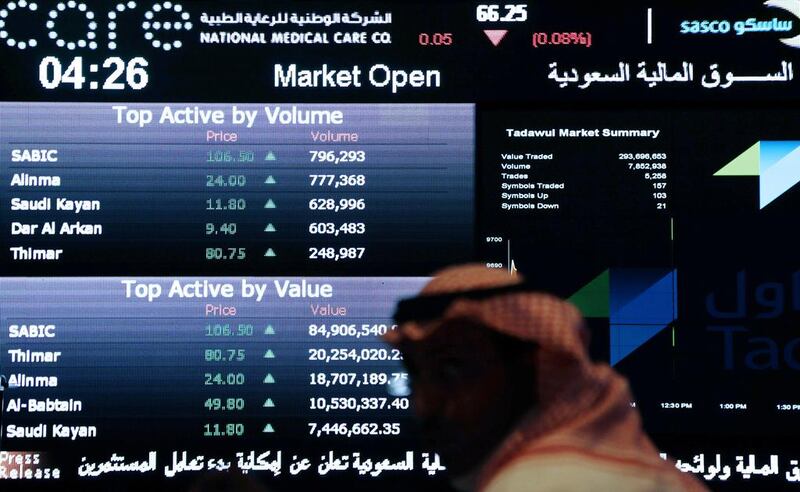The Saudi stock market rallied on Monday as the country unveiled a raft of economic targets that the deputy crown prince said will allow the country to wean itself off a reliance on oil by 2020.
The Tadawul, which had been in the red, rallied to finish up 2.5 per cent at the close after Prince Mohammed bin Salman spoke of the country’s vision for 2030 in an interview with Dubai-based Al Arabiya.
Vision 2030’s ambitious targets include selling up to 5 per cent of Saudi Aramco, creating a sovereign wealth fund with 7 trillion Saudi riyals (Dh6.85tn) in assets, and generating 97 billion riyals from the mining industry by 2020, the prince told Al Arabiya.
“This obviously is set to restore confidence and optimism in the general economy and this will be reflected of course in the stock market,” said Rami Sidani, the head of frontier investments at the asset manager Schroders.
“But we look for the long-term impact of this plan, which is said to trickle down to across the different sectors of the economy, especially given the increase in efficiency as you reduce dependency on subsidies and government spending and the increased involvement of the private sector.”
The plan also envisions boosting private-sector contribution to GDP to 65 per cent and boosting non-oil exports to 50 per cent of GDP by 2030, Al Arabiya reported.
__________
Full coverage
■ Saudi Arabia to wean itself off oil as part of economic transformation plan
■ Saudi Arabia cabinet approves Vision 2030 reform plan
■ Construction professionals welcome possible easing of Saudi visa restrictions
■ Saudi reform plan to transform flagship carrier into money-maker
■ Saudi lenders biggest winners in Vision 2030's outlook
■ Saudi Arabia: selected economic indicators – graphic
__________
Non-oil revenue will also be boosted from 136bn riyals to 1tn riyals by 2030, the channel said. The vision also projects lowering the unemployment rate to 7 per cent from 12 per cent.
“I think that the targets are far more reasonable than markets initially expected,” said John Sfakianakis, the director of economic research at the Riyadh-based Gulf Research Centre.
“I think the targets are realistic as long as the commitments and sustainability are there from the government side and of course from also the private sector.”
Saudi Arabia began reforms late last year, which the prince called “a quick fix”, that will continue this year to help steer the economy through the low oil price era. These reforms included raising prices of energy products, water and electricity and trimming spending to clamp down on a fiscal deficit that had reached 367bn riyals.
But these quick fixes will be accompanied by medium-term programmes aimed at lowering the fiscal deficit, which is projected to fall this year to 326.2bn riyals.
The programme also included incentives for the private sector to fill the gap created by reductions in government spending, currently the main driver for economic growth.
Already the IMF has lowered the country’s growth forecast to 1.2 per cent this year from 3.4 per cent last year, as the oil price plunge takes its toll on the economy.
“While reforms could accelerate growth through increased foreign investment, it will take some time for this to materialise,” said Giyas Gokkent, the senior economist for the Middle East and Africa at the Institute of International Finance (IIF).
“Privatisation could be key to attracting foreign investment inflows and be a significant source for one-off revenues, which could amount to more than 30 per cent of GDP over the medium to long term. However, the pace at which privatisation will be executed remains to be seen.”
“A number of measures could involve fiscal headwinds which may create political challenges.”
The IIF is forecasting a growth rate of 1.4 per cent for Saudi Arabia and a fiscal deficit reaching 14.2 per cent of GDP for this year.
dalsaadi@thenational.ae
Follow The National's Business section on Twitter






